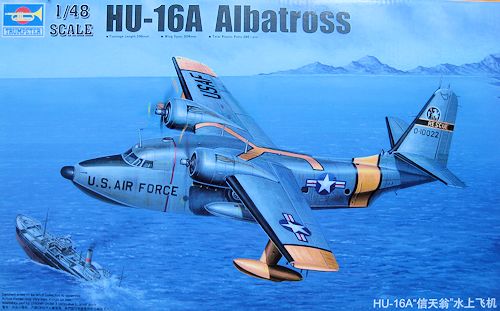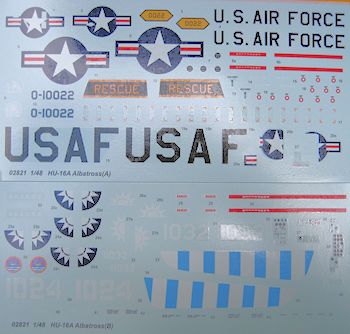
Trumpeter 1/48 HU-16A Albatross
| KIT #: | 02824 |
| PRICE: | $134.95 SRP |
| DECALS: | Two options |
| REVIEWER: | Vance Keeling |
| NOTES: | New tool kit |

| HISTORY |
The Grumman
Albatross was originally designed to be a USN Anti Submarine Warfare amphibian,
with the first prototype flying in 1947, and briefly named the Pelican.
Grumman continued the same basic design shape as the earlier Goose and
Widgeon, but in a much larger airframe.
An initial Navy order for thirty-two ASW A/C was later change to only six
utility versions for transport duties.
The USAF’s growing need for Sea Rescue aircraft led it to evaluate the
design. They picked up balance of
the Navy’s canceled contract and ordered additional aircraft.
Not to be left out, the Coast Guard also ordered the amphibian.
Each service had its own designation for the Albatross:
Air Force SA-16, Navy UF-1, and Coast Guard UF-1G.
This changed with the 1962 standardization of aircraft designations; The
Air Force Albatrosses became HU-16A, the Navy’s HU-16C, and Coast Guard’s
HU-16G.
Creeping weight gain on the HU-16s resulted in reduced performance, particularly under single engine conditions, where altitude could not be maintained. The Air Force initiated design changes, most notably increasing the wingspan from 80 feet to 96 feet eight inches, increasing the size and shape of the tail surfaces, and upgrading to a more powerful version of the R-1820 engine. The result was an aircraft that was faster, had a lower stall speed, increased cruise speed and range, and the ability to climb on one engine. Many of the older short wing (80’) aircraft were rebuilt to the new long wing standards. They became the HU-16B, HU-16D, and HU-16E for the Air Force, Navy, and Coast Guard. Hopefully, and as the parts breakdown of the Trumpeter kit would indicate, there will be a long wing version of the kit in the future, and possibly an ASW version.
| THE KIT |
 This
is my first Trumpeter kit, and it makes me understand why some reviews of other
Trumpeter kits indicated a company propensity for over engineering and excessive
parts count. This is a BIG
model for a twin engine aircraft, with a high parts count (380+).
The sturdy box has a separate compartment on one end to isolate the clear
parts (additionally wrapped in foam), metal parts, photo etch, and tires from
the rest of the sprues. All panel
lines inscribed on fuselage and wings are lightly done; not a trench to be seen!
Very small dimples represent the rivets on the underside of the hull and
wing floats.
This
is my first Trumpeter kit, and it makes me understand why some reviews of other
Trumpeter kits indicated a company propensity for over engineering and excessive
parts count. This is a BIG
model for a twin engine aircraft, with a high parts count (380+).
The sturdy box has a separate compartment on one end to isolate the clear
parts (additionally wrapped in foam), metal parts, photo etch, and tires from
the rest of the sprues. All panel
lines inscribed on fuselage and wings are lightly done; not a trench to be seen!
Very small dimples represent the rivets on the underside of the hull and
wing floats.
The finely
cast optional metal landing gear parts may allow the builder to avoid “saggy
gear syndrome”, caused by weight as the completed model ages.
The small fret of relief etched brass has shoulder and lap belts (rather
narrow) for the pilots seats only, a dozen assorted small parts, and three large
pieces meant to represent the canvas of the medical evacuation litters.
The relatively thin clear parts have the cockpit windows molded as part
of the forward upper fuselage.
Missing is the starboard circular window for the crew seat aft of the co-pilot
(Radioman/Crew Chief depending on service use).
This area could be buffed out and polished, and a round mask made to
replicate the window. The soft
vinyl-like tires raises the question of whether or not they will affect plastic
parts over time. Does anyone have
an opinion on the safety of these parts?
The build
instructions start with the detailed nose gear and well, after which you build a
complete fuselage interior, from the crew compartment forward bulkhead to the
APU/toilet bulkhead at the aft end of the passenger compartment.
This assembly then has the nose gear well and main mount wells attached.
The four part exterior fuselage sections then encase the interior.
Construction finishes with building and adding the stabilizers, wings
(all flying surfaces are separate and built of upper and lower parts), wing
floats, drop tanks (150 gallon?), main landing gear, engines, cowls, etc.
The propellers have individual blades
and appear to have a flat on the pin that inserts into the two-part hub to help
with alignment. There is something
odd (to my eyes) with the propeller blades.
The leading and trailing edge of each blade are not parallel with the pin
that inserts into the prop hub.
This makes the blades seem to be swept back a few degrees.
I don’t know if will still look strange after the propellers are
assembled.
Each R-1820
engine assembly is composed of forty-four parts, many of them quite small.
It looks like the carpet monster is going to be well fed!
It might be prudent to use reinforcement (brass tubing or square stock)
across the wing center section and outer wing panels to prevent wing droop or
joint failure.
The bow
compartment hatch is molded in place, with no interior.
There is no interior detail aft of the rear cabin bulkhead.
The pilots’ escape hatches, the top fuselage cargo hatch, the main
entrance hatch, and the starboard side JATO hatch are separate parts.
This creates the possibility of posing them open to allow viewing of much
of the interior detail. Oddly, no
hatches/doors are provided for the interior bulkhead openings (bow, flight deck,
and APU/toilet). Also missing are
the antenna posts over the wing center section to support the cat’s cradle of
communication and navigation antenna wires, and there is no antenna rigging
diagram. The bow mooring pendent,
overhead console engine control levers, entrance ladder, and tail scag (support
strut) are not modeled. It was
mandatory to have the tail support installed to protect the rear hull, as just
one or two people climbing into the aft cabin would cause the strut to come in
contact with the ground. The real
aircraft’s main wheel wells have large water drains that empty through oval
openings on each side of the keel aft of the main hull step.
These are not represented in the kit.
Markings:
 Decals are
provided for a USAF HU-16A #0-10022 in overall aluminum paint, with rescue
markings of yellow fuselage band, wingtips, and floats.
The yellow fuselage walkway marking are a bit of a puzzle to me.
The “Y” shape has curved arms leading to the engines and the base of the
“Y” angles to BOTH sides of the fuselage.
I haven’t seen any overhead photos showing curved walkways to the
engines; they are made up of sharp angles and straight lines.
The base of the “Y” angling to the starboard side doesn’t seem correct as
I am not aware that a fold-down footstep and recessed hand holds were outside
the starboard hatch, as there is for the portside main entry hatch.
Decals are
provided for a USAF HU-16A #0-10022 in overall aluminum paint, with rescue
markings of yellow fuselage band, wingtips, and floats.
The yellow fuselage walkway marking are a bit of a puzzle to me.
The “Y” shape has curved arms leading to the engines and the base of the
“Y” angles to BOTH sides of the fuselage.
I haven’t seen any overhead photos showing curved walkways to the
engines; they are made up of sharp angles and straight lines.
The base of the “Y” angling to the starboard side doesn’t seem correct as
I am not aware that a fold-down footstep and recessed hand holds were outside
the starboard hatch, as there is for the portside main entry hatch.
A second set
of markings is for a Taiwan HU-16A #1032 in Navy Blue (sort of a medium gray)
with white undersides and a yellow fuselage band.
It has the fuselage walkway in black outline form, with the same curved
“Y” shape and base access from both sides of the fuselage as with the USAF
markings.
The
instructions call for the entire inner surfaces of the fuselage and the cabin
deck and overhead to be interior green.
I would think a more logical scheme, and one backed up by reference
photos, would be a light gray, with dark gray on compartment bulkheads.
Caracal Models
is planning on releasing decal sets for the Albatross.
It would be
great to have the following to help fill up that cavernous fuselage:
A Gibson Girl radio pack, two 7-man life rafts, 10 to 12 parachute chest
packs, parachute harnesses, Mae West life preservers, and additional passenger
seats. I’d also like 300 gallon
drop tanks.
| CONCLUSIONS |
In spite of
my nit picking, this appears to be a great kit of a widely used and important
aircraft. I recommend it to anyone
with normal building skills and the ability to see and manipulate the many small
parts. The kit is an excellent
starting point for the many excellent super detailers in the modeling
fraternity.
| REFERENCES |
Naval
Fighters Number Eleven: GRUMMAN HU-16 ALBATROSS, by Steve Ginter
HU-16
Albatross in Action, Squadron Signal Aircraft Publication #161
GRUMMAN
ALBATROSS: A history of the Legendary Seaplane, by Wayne Mutza, Schiffer
Military History
(Former USN
ATN3 flying as radioman/radar operator on HU-16C 137930 & HU-16D 141279 out of
NAF Sigonella, Sicily in ’67 & ’68.)
Back to the Previews Index Page